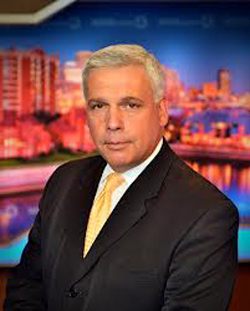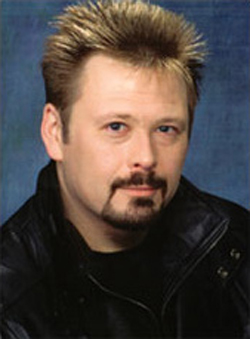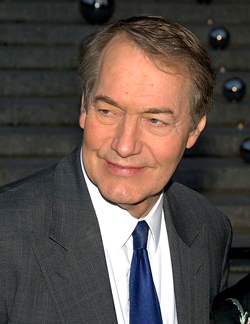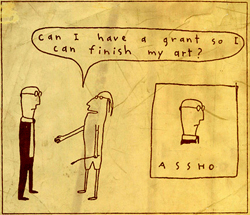Stop Taxing Working People to Subsidize Art
By Mike Hudson
 |
| Luke Moretti has risen through his talent. |
 |
| Tom Bauerle competes against subsidized NPR. |
 |
| Charlie Rose is subsidized by taxpayers. |
 |
I need to preface what I am about to say by telling you that, in my entire adult life, I have never done anything for a living other than play music and write. In the biographical notes that sometime appear with my published works, I am referred to as a “writer/musician” and, as such, have devoted an entire four-decade career to the arts.
Whether anything that’s come out of that has been any good or not is for others to decide, perhaps after I am dead.
But I’ve made a decent enough living and really can’t complain.
Over the years, I’ve gotten to know any number of other artists, some certifiably great, and others who, like me, must wait for final judgment.
I shook hands with Andy Warhol a couple of times, had a passing acquaintance with Norman Mailer, and met Chuck Berry. I’ve counted among my personal friends contemporary artists like Buffalo’s Philip Burke and Brooklyn’s John Morton, along with novelists like David Markson and Pete Hamill, and I’ve worked with musicians from the legendary bluesman Robert “Junior” Lockwood to Hall of Famers like the Ramones and Patti Smith.
All of this is neither here nor there other than to offer some credentials for a thesis both controversial and long held: It is my belief that any “art” subsidized in any way by any branch of the local, state or federal government equates necessarily to bad art. Government subsidies to the arts and all media are, by their very nature, patently unfair, and PBS, NPR, the NEA and, of course, our own NACC, should lose all public funding immediately.
Just look at Charlie Rose.
Here’s a guy who worked for NBC, ABC and CBS, couldn’t make it in the real world, then became a superstar with PBS because PBS doesn’t care if anybody watches it or not. The reason it doesn’t care is that its revenue comes from grants, gifts and tax dollars rather than advertising revenue generated, like the Super Bowl, say, in direct proportion to the number of eyes on the tube.
Why in the world should our own Luke Moretti – a fine reporter who would be out on his behind if he didn’t do a good job and people didn’t watch him – have to compete with Rose, who gets paid with our tax money, whether anybody watches him or not?
Why should Tom Bauerle have to compete against NPR’s “Morning Edition,” likewise paid for with tax dollars, and why should any artist starving in a garret have to watch helplessly as so many no talent bums who know nothing of art, but do know how to fill out grant applications, get funding from the NEA?
In Niagara Falls, like anywhere else, poseurs and two-bit chiselers who seek subsidies first before they can create great art are an insult to real artists who suffer and strive to make it.
The Australian Robert Hughes, the greatest art critic of the second half of the Twentieth Century, said there were only two kinds of art: Good art and bad art.
Assuming he was correct, and there’s no reason to think that he wasn’t, the feminist, African-American, gay and other categorizations of art so beloved by the bureaucrats who hand out grants and subsidies are meaningless.
It is good art or it is bad.
Quite often I am asked by young, aspiring writers and musicians for advice on how they should proceed. Always, that advice is the same. If you can do anything else, anything at all, do it and forget about playing a guitar or committing your thoughts and desires to paper. Just forget about it. Pretend you never even thought about it. Be a short order cook and marry a beautiful waitress.
Because artists, real artists, can’t do anything else. They get fired from dishwashing jobs because of ineptitude. Their personal relationships are a mess. They often find themselves addicted to booze or drugs, or are in treatment for those addictions. Their poverty and misery is genuine and art is messy.
The best of it is uncategorizable, because nothing like it ever existed before. The worst of it is what you get when the government becomes involved, boring, cookie cutter representations of the black experience or the lesbian experience or the experiences of those who grew up as abused children.
It appears on NPR and PBS, funded with grants through the NEA. It is everywhere and, in Niagara Falls, it should not be at the Niagara Arts and Cultural Center.
The chances that a piece produced under NACC auspices might one day hang in New York’s Metropolitan Museum, or chart in Rolling Stone or take its place in the American literary canon are, in my opinion, much higher, when the artist makes his art the sole product of his own endeavors, without depending on the taxpayer or the bureaucrat.
So what then is the purpose of all this government subsidized art?
If it’s not any good, why do the lawmakers in Washington and Albany and in Niagara Falls city hall keep throwing money at it?
Because when election time rolls around, it allows the politician to say “I support the arts,” which, if you do it with your own money, is a progressive and sensible position to take.
But if you’re doing it with other people’s money, money that rightfully belongs to taxpayers who worked hard for it at real jobs, there’s nothing noble about it at all.
It’s just another scam, another way for those who set themselves up as our “leaders” to make decisions for us, spending our money in way that, given a choice, we wouldn’t spend it ourselves.
At the end of the day, we would not want government subsidized newspapers, or government subsidized religion.
Why should art be any different?